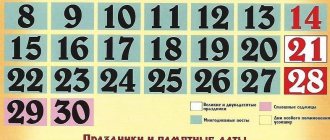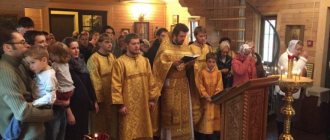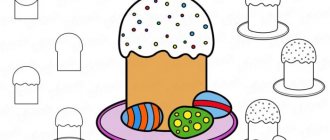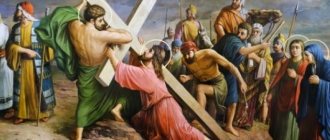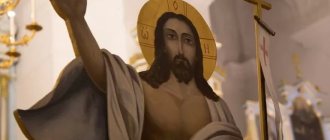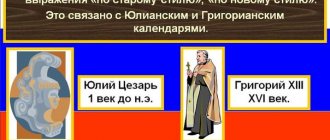Easter or the Resurrection of Christ is one of the greatest holidays for Orthodox Christians. This bright day reminds us that the Lord brought his son Jesus to earth, so that by his death he could cleanse our souls from sins and give hope for eternal life. The death and resurrection of Christ show humanity that our soul is immortal, and a righteous earthly life makes it possible to continue the life of the soul after death in paradise, next to God, and to protect the soul from the devil. In fact, each of us should know about this so that there is less envy, anger, and resentment in our world. And we need to start putting this knowledge into our heads and souls from early childhood, telling children the story of the birth, life, death and resurrection of Jesus. Of course, the Easter story for children should be somewhat different from the adult version - it is better for children to tell the story in a more accessible format, even if for them it sounds like a good fairy tale with a happy ending.
So, let's begin!
We focus on age
The ability to perceive and process information depends on the age of children. Therefore, adults should, first of all, focus their story about Easter on the age of the child. The level of intellectual development of the child is also important: someone already at the age of 5 is “leafing through” the works of Hegel - such children, of course, need concrete facts, without a “fairytale” frame, that is, a child’s interpretation. The division into age categories can be roughly divided into kindergarten groups.
A story about Easter may precede a trip to the Temple
Junior preschool age (1.5–3 years)
At this age, toddlers are just getting acquainted with the holiday. Moreover, the emphasis should be placed precisely on the fact that this is a holiday in order to evoke an association with fun and joy. As a basis for the story, you can take stories from the children's Bible. For very small children this will be enough.
After the kids get a general idea of the holiday, you can move on to getting acquainted with Easter customs: painting eggs, baking Easter cakes. It is important that, based on the materials, children can form a holistic impression of the essence of the holiday and its symbols . That is, it is better to use concise descriptions of the holiday rather than scattered excerpts.
The composition of a story about the history of the holiday for children of primary preschool age should include:
- the main stages of the life of Christ;
- the main features of his personality;
- the sequence of events that led to the painful death of Jesus on Calvary and the onset of Easter.
The story about Bright Resurrection can be timed to coincide with the joint preparation of festive treats
Middle preschool age (3–4 years)
Every year, when talking about Easter, you must repeat what was discussed last year. After repeating the general information that the kids received in past years, it is worth deepening their interest in the customs of the people, the symbols of the holiday, and also expanding their understanding of culinary traditions for Easter .
Moreover, the emphasis should be placed on the fact that these are ancient traditions. Here it would be appropriate to cite a number of Easter signs associated with the holiday.
Easter symbols
Parents should tell their children not only the history of Easter and how it is celebrated by Orthodox Christians, but also explain its symbolism.
The egg is a symbol of life. Painted red, it symbolizes Christ's sacrifice for all people and his rebirth to a new heavenly life.
Easter or Easter cakes are a symbol of the body of Jesus. Well, just delicious holiday bread with raisins and candied fruits.
Fire, a lit candle, is a symbol of eternal life and cleansing of the soul from bad thoughts and actions. On the eve of Easter in Jerusalem, the Holy Fire descends from heaven. Then particles of this fire are spread throughout all Christian churches in the world.
The celebration of Easter, the solemnity and joy with which parents prepare for the holiday: coloring eggs, preparing Easter cakes and larks - buns in the shape of birds, going together to church services - all this will be the best example for children of how to preserve and observe Christian traditions , believe in goodness and in God’s love for people.
Examples of well-written stories about the Holy Holiday
The main idea that needs to be conveyed to children in stories about Easter is that the soul continues to live even after the death of the body.
“Many, many years ago, more than two thousand, there lived a modest and kind girl Maria. As a reward for her mercy and patience [concepts worth explaining], the Lord made her the mother of his son, he was named Jesus. He loved people very much: he helped those in need, treated the sick and told people about God together with his friends - the 12 apostles. Those who were envious of Jesus, because people listened to him, planned to kill him. They entered into an agreement with one of Christ’s friends, Judas, who turned out to be a traitor. Jesus knew about the conspiracy, but was willing to voluntarily accept torture and death. He believed that such an act would help people cleanse themselves of bad deeds and thoughts and receive forgiveness from the Lord.
Recipe for “Royal curd Easter”
Another traditional dish for Easter is Easter cottage cheese. I have been looking for a long time for a good recipe, one that would process the products thermally. I found this one. In principle, I like it - it turns out delicious. It is better to cook on Saturday afternoon so that the mass is properly formed by Sunday morning.
Ingredients:
- cottage cheese 1 kg, preferably homemade, in any case fresh;
- butter - 250 grams;
- sugar - 1.5 cups;
- vanillin on the tip of a knife;
- fresh homemade or richer store-bought sour cream - 2 cups;
- chicken eggs - 2 pieces;
- nuts, raisins, dried apricots - 50 grams each (do not take walnuts, they turn the cottage cheese an unpleasant blue color);
- a little flour.
Squeeze the cottage cheese thoroughly, you can even use a press, then rub through a sieve and place in a saucepan in a water bath. Add sour cream, softened butter, eggs. Constantly stir the resulting mass, heating it. As soon as the first “bubbles” appear, remove from heat. Place the pan in the cold. I fill the sink with cold water and place the pan there. You need to stir periodically until the mixture cools down. At this time, fry the nuts so that they become drier, chop the dried apricots. Lightly roll raisins, nuts and dried apricots in flour and add to the cooled cheese mixture, add vanilla. Stir very well. Place in a special Easter mold lined with gauze, placed in a saucepan to drain the whey. After the whey has stopped separating, put the structure in the refrigerator until Sunday. It turns out like curd mass, only softer and tastier.
Materials for the story
In addition to the already mentioned sources of information, there is a large amount of material on the topic.
Works of art
Poems can be used to explain to children aged 1.5–5 years the essence of the holiday of Bright Resurrection.
For children 5–7 years old, excerpts or entire prose works can be included in the story, for example, for children 4–5 years old I. Belousov “Lilies of the Valley”, E. Velich “Met”, etc.
In addition, those who show a special interest in the topic, for example, in families where religion is treated with special reverence, can take advantage of the selection, which includes fairy tales, parables, stories by famous writers, and coloring books aimed at children of different ages.
You can reinforce the story with coloring pages and crafts on the topic.
Visual aid for telling the story of Easter
The educational story should be supported by visual ways of interacting with children. Therefore, the story about Easter must be well and appropriately illustrated. For this you can use:
- pictures on the topic (for example, biblical scenes, a festive table, a church service, Easter cakes, paints, etc.);
- videos (for example, videos with cartoons on the topic);
- presentations on a topic as an option for organizing disparate pictures into a single composition (examples of successful options are presented in the developments of A.Yu. Rudakova and G.A. Shlyundt) - this method of displaying pictures is especially convenient in families where the computer is a priority source of information.
Preparation for Easter - Lent
The path to the holiday is not easy. We need to endure Lent. Children under 7 years old do not have to follow it, just don’t force them to eat, remove the sweets. From the age of 7, church-going children must fast, completely abstaining from eating meat, fish, milk and eggs. On some days you can only eat fruits, vegetables and nuts, on others you can’t eat anything at all. Pregnant women, sick people, travelers and those who work in extreme conditions (firefighters, military personnel, etc.) do not fast.
Not all children can withstand such a difficult, strict fast. Treat them with understanding, consult with your spiritual mentor. Often, simply limiting the consumption of sweets and sweets during this time brings much more benefits than following the canons of nutrition. Everything is individual. The main meaning of fasting is the pacification of the flesh and the elevation of spirituality. Teach your child to do good deeds, get rid of his shortcomings, overcome fears and bad habits. This post is perfect for this.
The right mood
Be sure to approach this conversation responsibly. What matters is the mood of the children and the narrator himself. You shouldn’t tell your children what Easter is when they are excited about active play and their mother is annoyed by troubles at work. Of course, it’s good if children listen to this story at home, in a warm, tidy room and feel that their mother or grandmother is in some especially solemn and joyful mood.
Visiting a temple with children will create the right mood
The narrator must first read the relevant chapters of the Gospel. You can replace the story by reading the Children's Bible together, commenting on what you read along the way.
Easter traditions
Lent, which has strict prohibitions on many foods, is considered an unchangeable tradition before Easter. In particular, you cannot eat meat, eggs, fish, sweets, milk, baked goods, fast food or drink alcohol. Just before such a fast during the Maslenitsa holiday, one is allowed to eat plenty of eggs and dairy products in order to prepare physically and mentally for such a difficult test in Lent, which lasts 7 weeks in 2021, starting on March 11.
In churches, Divine services begin before midnight. The Midnight Service is served until midnight, and then Easter Matins begins. And then the procession around the temple begins.
Believers on this Bright Day greet each other like this: “Christ is Risen!” to which the other person must respond: “Truly He is Risen!” and so on three times. Previously, it was considered obligatory to kiss each other three times, and also exchange Easter eggs. According to tradition, it is customary to greet each other in this way not only on Easter itself, but also in the next 40 days after it.
Another ongoing tradition is the painting of Easter eggs, the Easter oven, and breaking the fast after Lent.
Also a week after Easter, Krasnaya Gorka week follows, during which usually all the young people have fun and can also have weddings. And on the 9th day there is a holiday called Radonitsa, where people go to the cemetery and remember the dead.
Pictures about Easter for children
When you select pictures, pay attention that among them there are many foreign ones. In English-speaking countries, it is commonly believed that at Easter a hare comes to children and brings eggs as a gift to children. Because if you and your baby decide to paint the eggs yourself and take them to the temple to consecrate, it’s stupid to say that the hare brought them, then it’s better to avoid such pictures altogether.
However, if the child is already old enough, you can explain that other countries have different customs. There, children do not decorate the eggs themselves, but think that the bunny gave them to them.
How to prepare for the holiday with your children
Each day of the last week before Bright Resurrection is associated with the last days of Jesus’ life on earth, with his teaching, with his relationship with his disciples. All preparations for the holiday are traditionally scheduled literally day by day. Follow them and prepare for Easter with your children.
- On the eve of the beginning of the pre-holiday week - on Palm Sunday - willow branches are brought into the house and placed in water so that it has time to bloom before the holiday. On this day, it would be a great idea to work with your children on making Easter crafts and gifts for loved ones.
- On Maundy Monday and Maundy Tuesday, together with your children, do spring cleaning in your apartment and throw out all the old and unnecessary trash, and if there are things that are good, but unnecessary, then it makes sense to take them to an orphanage or church to distribute to poor people. On these same days, Easter cakes are baked and eggs are painted. Children will really enjoy this process. Be sure to read with your children these days about the life of Jesus, about his last conversations with his disciples and people.
- On the day of Great Wednesday, go with your child to unction - a special evening service. Or just read to him the story of Jesus’ greedy disciple, Judas Iscariot, who is preparing to sell his teacher to the evil Jerusalem high priests for 30 pieces of silver.
- Maundy or Maundy Thursday is the time to remember the spiritual and go to the morning service. On this day, all Christians remember the Last Supper, at which Jesus gave communion to his disciples. Maundy Thursday is the right time to tell children about this event and explain its meaning.
- On Good Friday, read to children about the crucifixion of Christ, his death and the inglorious death of his traitor, Judas. On this day in the church during the evening service, the ministers bring the image of Christ in the tomb (the Holy Shroud) into the hall from the altar, and believing parents must take their children to it in order to receive cleansing and blessing.
- On Holy Saturday, after the morning service, the priest begins to sprinkle holy water and bless food for breaking the fast during the holiday. Children will find it interesting and edifying to attend such a ceremony.
There is no point in taking small children with you to the all-night holiday service and religious procession - it is tiring for the kids. But in the morning a festive table, delicious Easter cakes and krashenki (colored eggs) will be waiting for them.
Easter holiday fun and games for children
Any holiday for a child means fun, games, gifts and treats.
Easter is no exception. But on such a day, you shouldn’t let your child know that this holiday is exclusively for him and buy him a bunch of expensive gifts, invite a lot of guests... Easter is more of a family holiday, and the baby should understand that not only will they give him gifts, but he will too I must prepare something as a gift for my family. Crafts made from any material - plasticine, paper, beads, satin ribbons, pasta, cereals and peas or foamiram - should carry the main idea of the holiday, its spirit. Easter games and competitions are a mandatory attribute of this bright spring holiday.
- Egg Hunt is a fun game for the whole family. The driver hides painted or toy kinder eggs throughout the apartment or house (if it’s warm, then it’s better to hide it outside, buried in the sand or ground), and the rest look for them. A prize awaits the one who finds the most eggs.
- Egg breaking competition. Each child is given a colored egg, and they begin to “clink glasses” with everyone else in turn - the one whose egg remains intact on both sides wins.
- If there are a lot of children, then organize a fun egg relay race. An impromptu obstacle course is prepared for the children and they are divided into two teams. Place an egg in a tablespoon. Each team player must quickly get around all the obstacles without dropping the egg and pass it to the next player. After the relay, both the winners and the losing team receive tea and sweets.
- Rolling eggs down a slide. Previously, this game was played on the street, letting the egg roll down a real slide. At home you can make an impromptu slide. Whose egg rolls further is the winner.
- Another option for the skating rink is to place small objects (souvenirs, colored eggs, Kinders, sweets) at the bottom, under the slide. The player takes for himself the object that his testicle touched, rolling down the slide.
- "Blind Man's Bluff" with testicles. An egg is placed on a stool or chair. The child is placed next to the chair, blindfolded, spun, and then taken away from the chair. Trying to confuse him, they lead him not straight, but in different zigzags. The baby's task is to return to the testicle. He can remove the bandage only when he is sure that he has reached the right place. You cannot touch the chair and egg with your hands.
For even more games and entertainment for children during the Easter celebration, see the article “Easter Games for Children.”
Why did he die?
If the children are older, you can tell them the backstory. Jesus Christ (the son of God) came into this world to make people better. He urged them not to do bad things, not to cheat, not to steal, not to offend each other. He had many students and followers - those who believed him and followed him. But the Tsar who ruled at that time did not like it. He wanted people to listen only to him. And then the King ordered Jesus Christ to be crucified. If the children are still small, and you are afraid to traumatize them with stories about the crucifixion of Christ, then you can still say that the Tsar ordered the death of Christ. Older children can be told about the crucifixion and that since then the main symbol of Christianity is the crucifix.
Suitable setting
The setting in which the conversation takes place is also important. Let the children have the kindest and warmest memories of their first acquaintance with the good news of the Resurrection of Christ. Many parents watch cartoons about Christ with their children. This issue is left to their discretion. But, it is necessary to take into account that it is desirable that the image of God in a person’s mind should not be linked to cartoon pictures. It is better to watch a cartoon with a good instructive story and discuss together how this story can be interpreted from the point of view of Christianity. But God must remain for the child someone unknowable, not a face, but an image, a personality with a capital P.
You can use special children's books
What does Easter cake symbolize?
There are two interpretations of this symbol. First. Kulich is a round butter bread with a white “top” - a symbol of the church. The white airy crown means nothing more than the dome of the church.
Second. Previously, Easter cakes were baked not only for Easter, but also for other events, for example, before sowing. This bread was ritual: it symbolized a good harvest. That is why there should always be raisins in Easter cake - this is a symbol of seed and fertility.
